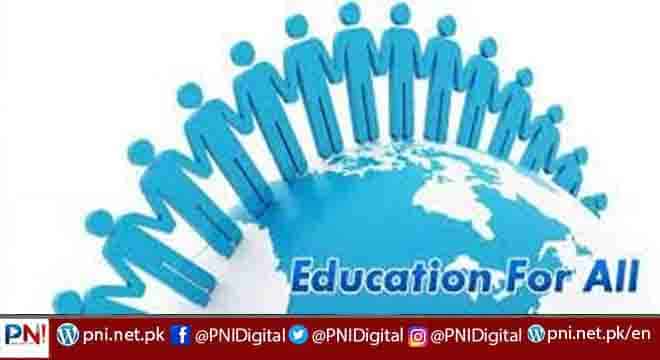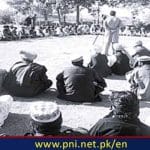ISLAMABAD, Mar 17 (APP):Amid changing scenario of science and technological developments, education has played a vital role to gear up the young generation for meeting the contemporary and future challenges being faced by the developing nations including Pakistan.
Like other SAARC countries, Pakistan is also confronting the gigantic challenge to bring around 20 million out-of-school children including about one million in Khyber Pakhtunkhwa under education-net.
Experts said the main reasons behind an increasing population of these children were socio-economic imbalances, poverty, rapid population growth and Covid-19 pandemic.
To bring these children under education-net, the KP government has embarked upon special initiatives and reforms geared towards development, digitization and improving service delivery in the education system through an inclusive Education Sector Plan (ESP).
Under ESP, Rs 166.47 billion investments was made by the KP government during 2019-20, yielding concrete results by reducing out-of-school children aged 05-16 years from 23 percent in 2016-17 to 20 percent in 2018, according to a report of Education and Elementary Education Department KP.
The students’ enrollment in government schools since 2013 has been increased by 16pc with substantial enhancement of 2.44pc in 2019-20 while teachers’ attendance was improved from 91 to 92 percent after introduction of Online Action Management System (OAMS), which resulted reduction in an unauthorized absence to 1.63 percent from 3.4 percent in 2016-17.
Sheikh Fakhar-e-Alam, Communication Specialist, Education Department KP told APP that like other socioeconomic sectors, Covid-19 has also made negative effects on students’ education due to closure of educational institutions and bringing such children back to schools was a challenge.
He said a special spring enrollment drive was started across the province to bring these children back to their schools.
“The second shift in 1,123 government schools began in KP including merged tribal districts after recruitment of 5,000 teachers through parents teachers councils (PTC),” he said, adding about 25,000 students had already been enrolled in these schools. He said Rs 337 million were released for recruitment of 1,240 teachers through PTC last year while the recruitment process of 3,000 school leaders started.
Besides recruitment of about 72,576 teachers for different cadres by the KP government, he said, every school would be provided a tablet PCs for education of young children. As per the Prime Minister’s ‘education for all vision’, he said government’s schools were being equipped with furniture worth Rs 6 billion that would facilitate 2.6 million children in KP.
Besides establishment of digital laboratories in over 50 schools under Early Age Program, 5,000 early childhood education (ECE) rooms were constructed while 100 ECE rooms are being built in underdeveloped merged tribal districts.
Under the Smart School Initiative, he said an MoU was signed with Hundreds of Original Projects for Employment (HOPE’87) to set up smart schools besides digitization of educational activities.
‘Halka Basta’ (less weight school bag) Act has been passed to facilitate one to 12th grade students while uniform education system from grade one to 5th class in all government schools implemented.
In merged tribal districts, 308 schools were constructed and upgraded while 100 ECE rooms and 240 science laboratories are being built besides 733 ECE rooms approved during the last three years.
Under the Prime Minister’s Rehmat-ul-Lilalameen scholarship program, he said 7,000 scholarships were being provided besides 360,000 scholarships to 60,000 talented students under Stars of KP and 0.9 million scholarships through Noon Academy.
“Private schools were stopped from collection of admission, promotion and capitation fees and only monthly fee would be collected form children,” he added.
Shahab Khan, Senior Planning Officer, Education Department told the news agency that 67 new schools were established and upgraded while feasibility of two new cadet colleges completed last year. He said 170 new schools including 50 primaries, 40 each middle to high and high to higher secondary would be established and upgraded in the current fiscal year while solarization of 8,000 schools, reconstruction of 700 earthquake affected schools besides reconstruction of 300 dilapidated schools was in progress.
In merged tribal districts, he said that 31 new schools were set up and upgraded last year while 75 new schools to be established and 1100 schools would be solarized during 2021-22.
About Rs 25 billion were spent on provision of basic facilities in schools during 2014-15 to 2017-18 facilitating over 83,000 students while Rs one billion were released to settled districts last year.
He said Rs 1.97 billion was released in 2019-20 for provisions of missing facilities including construction of boundary walls, additional rooms, clean drinking water and washrooms in tribal districts’ schools.
Under Schools Readiness Program (SRP), he said out of school Afghan refugees children would be prepared for enrollment initially in 35 government schools while under Post Primary Readiness Program, the refugees children would be facilitated in 10 schools in Peshawar, Nowshera and Swabi.
Annually, Rs132 million budget was spent on scholarships while 684 position holders were provided scholarships on merit. Regular stipend is being provided to 50,600 girl students ie Rs 2,400 per year to each girl student of class sixth to eighth and Rs 6,000 of class 9th to 10th.
“The stipend program in less developed Batagram and Lakki Marwat has helped increased girls’ enrollment by 51 percent in last fiscal year,” he said adding Rs 600 per month for girl student of grades Kachi, one and six classes, Rs 1500 per month for ninth grade and Rs 3,000 for 10th grade were being provided.
The government has started working on Rs 3.71 billion project for the provision of scholarships to all primary and secondary students of merged tribal districts that would benefit about 553,062 tribal students.
Besides launching the E-transfer policy, he said the Independent monitoring unit was institutionalized as Education Monitoring Authority (EMA) and its role was expanded to merged tribal districts.
Zariful Maani, Managing Director, Elementary and Secondary Education Foundation (ESEF) said that 500 new community schools were established last year in the province, raising its total number to 3,500 schools with increased enrollment of 1,56,000 students.
Mani said 1,000 more such schools would be established to bring out-of-school children of remote areas under education cover. He said digital profiling of students and teachers completed to ensure their daily online attendance while outstanding salaries of teachers worth Rs 850 million cleared last year.
Follow the PNI Facebook page for the latest news and updates.








